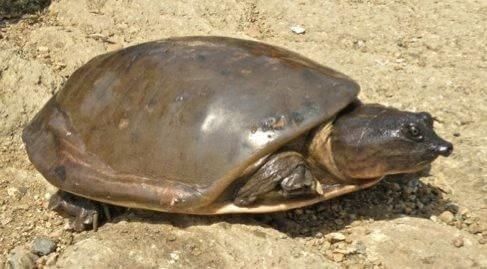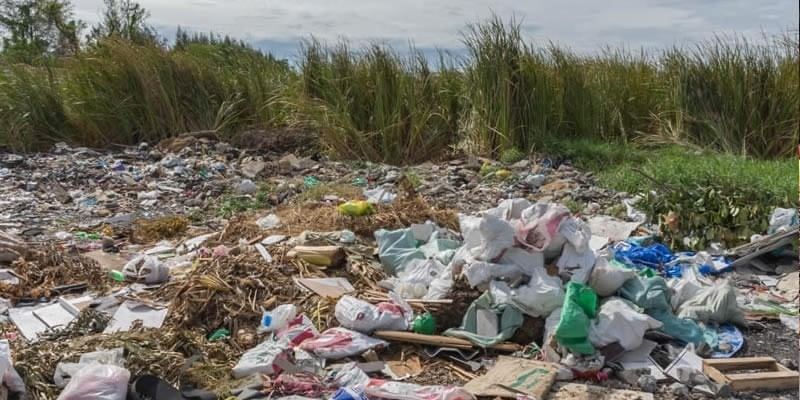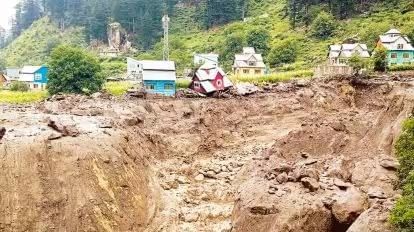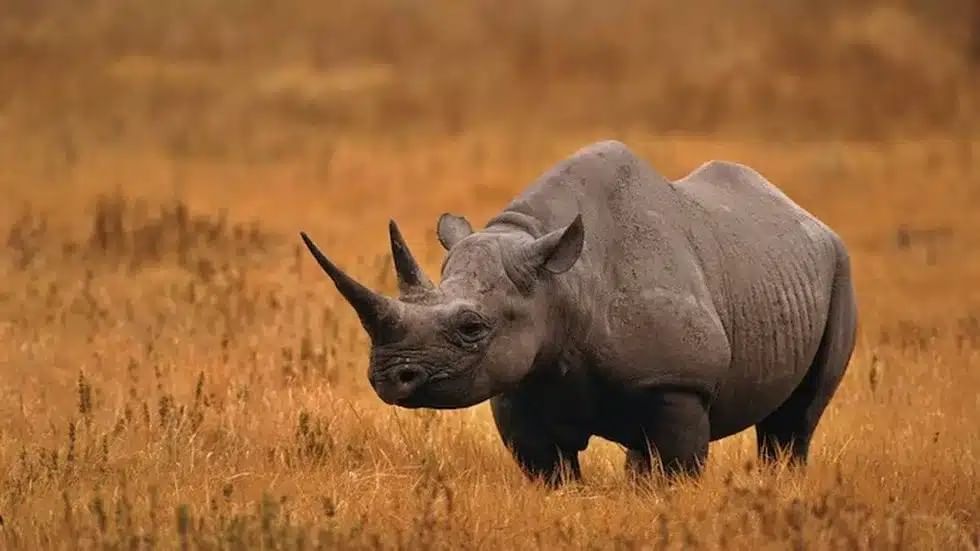Environment and Ecology: August 2025 UPSC Current Affairs | Environment for UPSC CSE PDF Download
GS3/Environment
Indian Flapshell Turtle (Lissemys punctata)
 Why in News?
Why in News?The Social Forestry Department of Vadodara has recently rescued an albino Indian flapshell turtle (Lissemys punctata) from a freshwater lake located in Chikhodra, Gujarat. This incident highlights the conservation challenges faced by this species.
Key Takeaways
- The Indian flapshell turtle is a small freshwater softshell turtle native to South Asia.
- It is recognized for its unique femoral flaps that cover its limbs when retracted.
- This turtle species is listed as vulnerable on the IUCN Red List and is protected under various conservation laws.
Additional Details
- Geographic Range: The Indian flapshell turtle is found across several countries including India, Pakistan, Nepal, Bangladesh, Sri Lanka, and Myanmar.
- River Systems: It inhabits major river basins such as the Indus, Ganges, Irrawaddy, and Salween.
- Habitat: This turtle prefers shallow, quiet freshwater environments like rivers, ponds, lakes, marshes, and canals with sandy or muddy bottoms ideal for burrowing.
- Conservation Status:
- IUCN Red List: Vulnerable
- CITES Listing: Appendix II
- Wildlife (Protection) Act, 1972: Schedule I (maximum protection)
- Major Threats:
- Poaching for meat and use in traditional medicine.
- Illegal trade for fishing bait, livestock feed, leather, and as exotic pets.
- Habitat loss due to pollution, encroachment, and destruction of water bodies.
- Albino individuals are particularly targeted in the illegal pet market.
The Indian flapshell turtle’s situation emphasizes the need for increased conservation efforts and awareness to protect this vulnerable species from ongoing threats.
GS3/Environment
District Flood Severity Index (DFSI)
 Why in News?
Why in News?
Researchers from IIT Delhi and IIT Gandhinagar have introduced the District Flood Severity Index (DFSI). This index aims to enhance flood planning by utilizing historical data along with indicators reflecting human impact.
Key Takeaways
- The DFSI serves as a comprehensive, data-driven assessment of flood severity across various districts in India.
- It focuses on district-level analysis, which is crucial for effective disaster management planning and implementation.
Additional Details
- Data Collection: The index is based on long-term data collected annually by the India Meteorological Department (IMD) since 1967, specifically regarding major flood events.
- Significance: The DFSI addresses the absence of a national index that evaluates not only the magnitude of floods but also other critical factors.
- Key Parameters Used in DFSI:
- Mean flood duration (in days) per district.
- Percentage of district area historically affected by floods.
- Total deaths and injuries attributed to floods.
- District population, which is used to evaluate the per capita impact of flooding.
- A 40-year curated dataset from IIT Delhi for historical flood mapping.
- Key Insights from the Index:
- Thiruvananthapuram (Kerala) recorded the highest number of flood events (231) but is not among the top 30 severely impacted districts according to the DFSI.
- Patna (Bihar) ranks #1 on the severity index, primarily due to a higher population impact and extensive flood spread.
- Assam districts such as Dhemaji, Kamrup, and Nagaon frequently experience high flood instances (over 178 events), yet their ranking is contingent on a combination of various indicators.
The District Flood Severity Index represents a significant advancement in understanding and managing flood risks at the district level in India, enabling better preparedness and response strategies.
GS3/Environment
The Impact of Plastic Pollution on Health

Why in News?
Plastic pollution has emerged as a critical environmental crisis, drawing attention globally as discussions in Geneva involving 180 countries have failed to reach a binding legal agreement to address it. This reflects significant divisions on whether to focus on waste management alone or include production in the treaty.
Key Takeaways
- Plastic pollution now includes serious health implications, moving beyond traditional waste management concerns.
- Plastics contain over 16,000 chemicals, with limited knowledge about many of them.
- Microplastics have been found in human blood, breast milk, placenta, and bone marrow, underscoring the urgency of the issue.
Additional Details
- Global Plastic Treaty Deadlock: The recent negotiations have revealed a divide between countries focusing on waste versus those advocating for production regulations. This deadlock highlights the challenges in establishing a unified approach.
- Health Risks: Chemicals found in plastics, such as bisphenols and phthalates, are linked to various health issues including thyroid dysfunction, hypertension, and certain cancers. Studies involving over 1.1 million individuals are ongoing to further understand these connections.
- The Microplastic Menace: Defined as plastics smaller than 5 mm, microplastics are increasingly found in human biological samples, raising concerns about their potential health impacts.
- Policy Responses: Various countries, including India, have initiated measures such as bans on single-use plastics and are navigating the complexities of international negotiations regarding plastic pollution. However, health impacts are often sidelined in these discussions.
The ongoing discussions in Geneva signify a critical juncture in addressing plastic pollution. Ignoring the health risks associated with plastics creates a significant gap in policy. A comprehensive treaty that encompasses both production and health impacts is vital for mitigating the potential dangers plastics pose to human health in the 21st century.
GS3/Environment
Jellyfish and Their Impact on Marine Ecosystems

Why in News?
Recently, a significant nuclear power plant in France was temporarily shut down due to an unexpected issue involving jellyfish, which exemplifies the ecological challenges posed by these organisms.
Key Takeaways
- Jellyfish are resilient marine organisms belonging to the phylum Cnidaria.
- They possess a simple anatomy and unique features such as stinging tentacles and jet propulsion.
Additional Details
- Characteristics of Jellyfish:
Jellyfish are simple invertebrates that exhibit radial symmetry, allowing them to sense their environment from all directions. They lack complex organs such as brains, blood, and hearts.
- Anatomy:
Their bodies are composed of three distinct layers: the outer epidermis, a middle layer known as mesoglea that is jelly-like and elastic, and an inner layer that completes their structure.
- Ecological Impact:
Massive jellyfish blooms lead to disruptions in marine ecosystems by:
- Reducing biodiversity
- Outcompeting native species
- Collapsing fish and invertebrate populations
- Reasons for Jellyfish Blooms:
- Global Warming: Increased ocean temperatures have resulted in a surge of plankton, the primary food source for jellyfish, enabling their population growth.
- Overfishing: The removal of species like tuna and sea turtles, which prey on jellyfish, has allowed jellyfish populations to thrive unabated.
- Plastic Pollution: Jellyfish's ability to tolerate low oxygen levels in polluted waters has further facilitated their population increase.
Overall, the presence and proliferation of jellyfish represent both a unique biological phenomenon and a serious ecological challenge, highlighting the intricate balance within marine environments.
GS3/Environment
India to Launch First Sustainable Aviation Fuel Plant
 Why in News?
Why in News?
The Indian Oil Corporation (IOC), the largest refiner and fuel retailer in India, is preparing to initiate commercial production of Sustainable Aviation Fuel (SAF) at its Panipat refinery by December 2025. This facility has recently been certified for the production of biofuel from used cooking oil (UCO). By the end of the year, IOC aims to achieve an annual production capacity of 35,000 tonnes of SAF, sourcing raw materials from large hotel chains, restaurants, and food companies that typically discard cooking oil after its first use. This development represents a crucial advancement in India’s green aviation initiative, contributing to a transition towards cleaner energy and reducing reliance on traditional jet fuel.
Key Takeaways
- IOC is set to produce 35,000 tonnes of SAF annually by 2025.
- The facility is certified to manufacture biofuel from used cooking oil.
- This initiative is part of India’s broader green aviation strategy.
Additional Details
- Sustainable Aviation Fuel (SAF): SAF is a bio-based alternative to conventional jet fuel, derived from renewable feedstocks such as used cooking oil, agricultural residues, and non-edible crops.
- SAF is a “drop-in fuel,” allowing it to be blended with existing jet fuel and used in current aircraft without requiring modifications.
- International aviation bodies certify blending limits (typically up to 50%) to ensure safety and performance.
- Environmental Benefits: 100% SAF can reduce greenhouse gas emissions by up to 94%, depending on the feedstock and production technology.
- Economic Opportunities: The initiative creates new markets for farmers through non-edible crops and waste collectors for used cooking oil.
- Export Potential: European airlines are expected to be primary buyers of IOC’s SAF, with plans to tap into global export markets as demand increases.
- Regulatory Compliance: Starting in 2027, airlines must offset emissions beyond 2020 levels, making SAF blends a key compliance method.
IOC's SAF plant will initially meet India's 1% SAF blending target for international flights by 2027, as set by the National Biofuel Coordination Committee (NBCC). The committee has indicated targets of 1% blending in 2027 and 2% in 2028. As the market matures, domestic SAF blending is expected to follow after international targets are established. However, challenges such as UCO collection from small eateries and high production costs remain. Additionally, while IOC is starting with UCO, the company is also exploring alcohol-to-jet (ATJ) technology for sustainable fuel production.
GS3/Environment
Groundwater Contamination - A Public Health Emergency
Why in News?
India is facing a severe groundwater contamination crisis, posing significant public health threats linked to chronic illnesses across various states. The 2024 Annual Groundwater Quality Report by the Central Ground Water Board (CGWB) highlights alarming contamination levels, emphasizing the need for immediate systemic reforms.
Key Takeaways
- Groundwater is crucial for over 85% of rural drinking water and 65% of irrigation needs in India.
- Contaminants include nitrates, heavy metals, industrial pollutants, and pathogenic microbes.
- The crisis is no longer just an environmental issue; it is a nationwide public health emergency.
Additional Details
- Scale and Nature of Groundwater Contamination:Groundwater samples from over 440 districts show dangerous levels of contaminants such as:
- Nitrates: Present in over 20% of samples, primarily due to excessive fertilizer use and septic tank leaks.
- Fluoride: Exceeds safe levels in over 9% of samples, leading to dental and skeletal fluorosis.
- Arsenic: Unsafe levels found in Punjab, Bihar, and the Gangetic belt, associated with severe health risks.
- Uranium: Detected above 100 ppb in certain districts, linked to phosphate fertilizers and over-extraction.
- Iron and Heavy Metals: Over 13% of samples exceed safe iron limits, with lead and mercury traced back to industrial discharges.
- Documented Health Impacts:The health consequences of groundwater contamination are extensive:
- Fluorosis: Affects over 66 million people; leads to joint pain and deformities in children.
- Arsenicosis: Causes skin lesions and cancers; prevalent in West Bengal, Bihar, and Uttar Pradesh.
- Nitrate Poisoning: Linked to “blue baby syndrome” in infants; 56% of districts exceed safe limits.
- Uranium Toxicity: Causes chronic organ damage, posing high risks for children.
- Waterborne Diseases: Outbreaks of cholera, dysentery, and hepatitis due to sewage infiltration.
- Case Studies of Groundwater “Death Zones”:
- Baghpat, Uttar Pradesh: 13 deaths linked to kidney failure from industrial effluents.
- Jalaun, Uttar Pradesh: Petroleum-like fluids in handpumps suspected from underground fuel leaks.
- Paikarapur, Bhubaneswar: Hundreds fell ill due to sewage-contaminated groundwater from a faulty treatment plant.
- Root Causes of the Crisis:
- Fragmented Governance: Multiple agencies operate in silos, reducing policy effectiveness.
- Weak Legal Framework: The Water Act of 1974 inadequately addresses groundwater issues.
- Inadequate Monitoring: Lack of real-time data hampers early detection of contamination.
- Over-Extraction: Reduces water tables, concentrating pollutants and mobilizing toxins.
- Industrial Negligence: Limited oversight allows for illegal discharges and untreated waste.
- Pathways to Reform:
- National Groundwater Pollution Control Framework: Establish clear responsibilities and empower CGWB.
- Technology-Driven Monitoring: Utilize real-time sensors and satellite imaging for better data access.
- Health-Centric Interventions: Community-based defluoridation and arsenic removal units.
- Zero Liquid Discharge Mandates: Implement strict regulations for industrial effluents.
- Agrochemical Management: Promote organic and balanced fertilization practices.
- Citizen Participation: Empower local bodies to monitor and report water quality.
This crisis necessitates immediate action to safeguard groundwater and protect public health, highlighting the importance of collaborative efforts among government agencies, communities, and individuals.
GS3/Environment
Vaquita Conservation Efforts and Challenges
Why in News?
A recent report by the North American Environmental Commission has highlighted Mexico's inadequate measures to protect the critically endangered vaquita porpoise, with alarming estimates indicating that only ten individuals remain in the wild.
Key Takeaways
- The vaquita is the smallest porpoise species, making it the most endangered marine mammal globally.
- Its habitat is primarily limited to the northern Gulf of California, where it thrives in shallow waters rich in fish and shrimp.
- Current conservation status: Critically Endangered according to the IUCN.
Additional Details
- Vaquita Characteristics: Vaquitas are distinguished by their chunky bodies and rounded heads, lacking pronounced snouts, which sets them apart from dolphins. Their dorsal fins are notably taller and wider than those of other porpoises.
- Behavior: Known for their elusive nature, vaquitas tend to avoid boats and human interactions. They utilize echolocation, emitting high-frequency clicks for communication.
- Threats: The drastic decline in the vaquita population is largely attributed to the illegal fishing of totoaba, a fish species endemic to the Gulf of California, which is hunted for its valuable swim bladder.
With just ten vaquitas left, urgent action is required to prevent their extinction. The ongoing threats and challenges pose significant barriers to conservation efforts, underscoring the critical need for effective protective measures.
GS3/Environment
Anamalai Tiger Reserve

Why in News?
A recent year-long study conducted by the Tamil Nadu Forest Department has revealed that at least eight different species of fireflies contribute their bioluminescence to the forests of Anamalai Tiger Reserve.
Key Takeaways
- The Anamalai Tiger Reserve is located at an altitude of 1400 m in the Anamalai Hills, spanning the Pollachi and Coimbatore Districts.
- This protected area was designated a tiger reserve in 2007, highlighting its ecological significance.
- It features a rich diversity of vegetation, hosting various habitat types and flora.
Additional Details
- Location:The Anamalai Tiger Reserve is situated south of the Palakkad Gap in the Southern Western Ghats. It is bordered by:
- Parambikulam Tiger Reserve to the east
- Chinnar Wildlife Sanctuary and Eravikulam National Park to the southwest
- Several reserved forests of Kerala, including Nenmara, Vazhachal, Malayattur, and Marayur.
- Indigenous Communities: The reserve is home to six indigenous communities: Kadar, Muduvar, Malasar, Malai Malasar, Eravalar, and Pulayar.
- Vegetation:The area supports a variety of habitats, including:
- Wet evergreen forests
- Semi-evergreen forests
- Moist and dry deciduous forests
- Dry thorn and shola forests
- Unique montane grasslands, savannah, and marshy grasslands.
- Flora:The reserve boasts a rich diversity of flora, including wild relatives of cultivated species such as:
- Mango
- Jackfruit
- Wild plantain
- Ginger (Zingiber officinale)
- Turmeric
- Pepper (Piper longum)
- Cardamom
- Fauna:Key wildlife species found in the reserve include:
- Tiger
- Asiatic elephant
- Sambar
- Spotted deer
- Barking deer
- Jackal
- Leopard
- Jungle cat
The findings from the study underscore the ecological richness of the Anamalai Tiger Reserve and its importance in conserving biodiversity, particularly the unique firefly species.
GS3/Environment
Gorumara National Park: A Conservation Success
 Why in News?
Why in News?
The population of the greater one-horned rhinos at Gorumara National Park in Jalpaiguri has seen a positive increase with the recent birth of two rhino calves, marking a significant win for conservation efforts in the region.
Key Takeaways
- Gorumara National Park is located in Jalpaiguri, West Bengal.
- It covers an area of approximately 79.45 sq.km and was established as a national park in 1992.
- The park is renowned for its rich biodiversity, particularly the endangered one-horned rhinoceros.
Additional Details
- Location: Gorumara National Park is situated in the Terai region of Dooars, at the foothills of the Eastern Himalayas, alongside the Murti and Raidak rivers.
- Flora:The park features a variety of vegetation, including:
- Sal forests with Common Teak and Rain Trees (Albizia lebbeck)
- Bamboo groves and Terai grassland
- Tropical riverine reeds and numerous tropical orchids
- Fauna:The park is home to a diverse array of wildlife, including:
- Indian rhinoceros
- Asian elephant
- Indian bison
- Leopard, sambar deer, barking deer, spotted deer, and wild boar
- Various bird species like peafowl, red jungle fowl, and the Indian hornbill
- Greater One-Horned Rhino:
- Scientific Name: Rhinoceros unicornis
- Distribution: Found in India and Nepal, particularly in the Himalayan foothills.
- Habitat: Prefers semi-aquatic environments, swamps, forests, and areas near nutritious mineral licks.
- Physical Characteristics: Males weigh around 2,200 kg and have a distinctive single horn that can be 8-25 inches long.
- Behavior: Generally solitary, except for females with calves; primarily grazers feeding on grasses, leaves, and aquatic plants.
- Conservation Status: Classified as Vulnerable on the IUCN Red List.
The recent increase in the one-horned rhino population at Gorumara National Park highlights the ongoing conservation efforts and the importance of preserving such habitats for endangered species.
GS3/Environment
Kishtwar Flash Floods: Role of Climate Change in J&K’s Extreme Weather

Why in News?
Recently, Kishtwar in Jammu & Kashmir faced devastating flash floods after heavy rainfall, resulting in the tragic loss of at least 65 lives and leaving over 50 people missing. This calamity occurred near the Machail Mata temple route, highlighting the increasing frequency of extreme weather events in the region.
Key Takeaways
- Jammu & Kashmir has witnessed a surge in extreme weather events, with significant impacts attributed to climate change.
- Between 2010 and 2022, the region recorded 2,863 extreme weather events, causing 552 fatalities.
- Heavy snowfall has been the deadliest weather phenomenon, leading to 182 deaths during this period.
Additional Details
- Extreme Weather Events: The most common events in J&K include thunderstorms (1,942 incidents) and heavy rain (409 incidents), with landslides (186 incidents) also posing notable threats.
- Key Drivers of Extreme Weather: The primary factors contributing to these events are rising temperatures, changes in Western Disturbances, and the region's unique topography.
- Since 2000, the western Himalayas have warmed at twice the rate of the Indian subcontinent, intensifying precipitation and increasing the frequency of severe rainfall.
- Glacial shrinkage has led to the formation of unstable glacial lakes, which pose risks of sudden floods when heavy rain occurs.
- Western Disturbances: These weather systems are now affecting regions outside their traditional winter months, increasing the likelihood of heavy rainfall and floods.
- The topographical features of Jammu & Kashmir, including its mountainous terrain, exacerbate the impact of climate change, making the area more susceptible to flash floods and landslides.
The increasing incidence of extreme weather events in Jammu & Kashmir underscores the significant impact of climate change on the region, necessitating urgent attention and action to mitigate these disasters.
GS3/Environment
Pollution Control can Levy Environmental Damages: Supreme Court Ruling

Why in News?
A landmark ruling by the Supreme Court of India has granted Pollution Control Boards (PCBs) the authority to impose and collect restitutionary and compensatory damages under the Water and Air Acts. This decision is pivotal in enhancing the enforcement of environmental protection standards across the country.
Key Takeaways
- The Supreme Court has empowered PCBs to impose and collect damages related to environmental harm.
- PCBs can demand bank guarantees in anticipation of potential environmental damage.
Additional Details
- Legal Basis:The ruling is grounded in:
- Section 33A of the Water Act, 1974: Grants authority to direct the closure or regulation of industries that violate water pollution norms.
- Section 31A of the Air Act, 1981: Provides similar powers to control air pollution, with non-compliance recognized as a legal violation.
- Central Pollution Control Board (CPCB): Established in September 1974 under the Water Act, the CPCB is a statutory technical body responsible for promoting clean air and water. It operates under the Environment (Protection) Act, 1986.
- Key Functions of CPCB:
- Control and abate water and air pollution; promote cleanliness of streams and wells.
- Advise the Central Government on pollution-related issues.
- Coordinate with State Pollution Control Boards (SPCBs) and resolve disputes.
- Monitor pollution in Union Territories through powers delegated under relevant Acts.
- Develop and revise National Ambient Air Quality Standards and Water Quality Criteria.
- State Pollution Control Boards (SPCBs): Formed by State Governments, these boards monitor and control local pollution, enforce compliance, and conduct awareness campaigns.
This ruling emphasizes the importance of proactive measures in environmental governance, enabling PCBs to take decisive actions against pollution and thereby enhancing the protection of natural resources in India.
GS3/Environment
Bacterial Cause Behind Mass Starfish Deaths
 Why in News?
Why in News?
Since 2013, an alarming phenomenon has occurred along North America's Pacific coast, where over 5 billion starfish have died due to a wasting disease. This disease has now been linked to Vibrio pectenicida, a bacterium related to cholera.
Key Takeaways
- Over 5 billion starfish deaths recorded since 2013.
- Vibrio pectenicida identified as the causal agent of the disease.
- Major impact on the sunflower sea star population, which declined by 90%.
Additional Details
- About Starfish (Sea Stars):
- Taxonomy: Belong to the phylum Echinodermata; exclusively marine organisms.
- Species include: Brisingida, Forcipulatida, Velatida, Valvatida, and Spinuloside.
- Body Structure:
- Exhibits radial symmetry in adults and bilateral symmetry in larvae.
- Has a calcareous exoskeleton for protection.
- Features a water vascular system for respiration and circulation.
- Unique Features:
- Regeneration of lost limbs.
- Lack of blood or brain; nutrients circulated via seawater.
- Eyespots at arm tips to sense light.
- Tough skin made of calcium carbonate.
- Feeding Habits: Starfish can be carnivorous, detritivorous, or scavengers.
- Ecological Consequences:
- Starfish are keystone predators, especially of sea urchins.
- Their decline has led to increased sea urchin populations, causing overgrazing of kelp forests.
- This has resulted in biodiversity loss and reduced carbon sequestration.
This situation highlights the complex interdependencies in marine ecosystems, where the decline of a single species can lead to significant ecological consequences.
GS3/Environment
Discovery of New Palm Species ‘Phoenix roxburghii’

Why in News?
A new palm species, ‘Phoenix roxburghii’, which was first described in the 17th-century botanical work Hortus Malabaricus, has recently been confirmed as a distinct species.
Key Takeaways
- The species is named after William Roxburgh, known as the father of Indian Botany.
- It is distributed across various regions including India’s eastern coast, Bangladesh, Gujarat, Rajasthan, and Pakistan.
- It can grow up to 12–16 metres, making it taller than Phoenix sylvestris.
Distinct Features
- Trunk: Solitary trunk.
- Leaves: Larger leaves and leaflets compared to other species.
- Flowers: Musty-scented staminate flowers.
- Fruits: Large, obovoid orange-yellow fruits.
Back2Basics: India’s Oil Palm Scenario
- National Mission on Edible Oils – Oil Palm (NMEO-OP) (2021): A centrally sponsored initiative aimed at increasing domestic crude palm oil (CPO) production to reduce import reliance.
- Targets:
- Expand cultivation area to 10 lakh hectares by 2025-26.
- Increase production from 0.27 lakh tonnes (2019-20) to 11.2 lakh tonnes (2025-26) and further to 28 lakh tonnes by 2029-30.
- Support Mechanisms: Includes Viability Price (VP), Direct Benefit Transfer (DBT), planting subsidy (₹29,000/ha), and special assistance for Northeast and Andaman regions.
- Cultivation States: Major production occurs in Andhra Pradesh, Telangana, and Kerala (accounting for 98% of output), with others including Karnataka, Tamil Nadu, Odisha, Gujarat, and Northeast states.
- Potential vs Current: India has a potential of 28 lakh hectares for palm oil cultivation, but only 3.7 lakh hectares are currently cultivated.
- Imports: India is the world’s largest palm oil importer (9.2 million tonnes in 2023-24), with palm oil constituting 60% of its edible oil imports, predominantly sourced from Indonesia, Malaysia, and Thailand.
- Unique Advantage: Palm oil yields are significantly higher, being 5× higher than traditional oilseeds.
UPSC 2021 Question
With reference to ‘palm oil,’ consider the following statements:
- 1. The palm oil tree is native to Southeast Asia.
- 2. Palm oil is a raw material for some industries producing lipstick and perfumes.
- 3. Palm oil can be used to produce biodiesel.
Which of the statements given above are correct?
Options: (a) 1 and 2 only (b) 2 and 3 only* (c) 1 and 3 only (d) 1, 2, and 3
This discovery not only adds to the biodiversity knowledge but also highlights the importance of palm oil in India's agricultural and economic landscape.
GS3/Environment
Teak Defoliator Moth and Its Biocontrol Solution
 Why in News?
Why in News?
The Kerala Forest Research Institute has successfully identified and mass-produced the Hyblaea puera Nucleopolyhedrosis Virus (HpNPV), providing an eco-friendly alternative to chemical pesticides. This innovative approach aims to prevent extensive defoliation of teak trees caused by the teak defoliator moth (Hyblaea puera).
Key Takeaways
- Hyblaea puera is a significant pest that severely affects teak trees and mangroves.
- The HpNPV virus offers a promising biocontrol method to combat this pest.
- Annual outbreaks of the moth lead to considerable economic losses in timber production.
Additional Details
- About Teak Defoliator Moth: This moth is a cryptic species recognized as a major pest of teak trees, impacting their growth and health.
- Impact on Teak Trees: The larvae of the moth initiate damage with the arrival of monsoon rains, leading to energy diversion from growth to leaf regeneration.
- Nature of Damage: The moths devour the leaves, often leaving only the midrib intact, significantly affecting the tree's health.
- Geographical Distribution: Native to South Asia and Southeast Asia, it is found in forests from India to Australia.
- Economic Impact: The teak defoliator causes substantial economic losses during its seasonal outbreaks, affecting timber production.
- Hyblaea puera Nucleopolyhedrosis Virus (HpNPV): This virus is recognized as a potential biocontrol agent that can cause lethal infections in pest larvae, preventing widespread defoliation. It can multiply extensively inside a single larva, releasing vast amounts of inoculum upon death.
The development of HpNPV represents a significant advancement in sustainable pest management, offering an effective solution to protect teak plantations from the destructive impacts of the teak defoliator moth.
GS3/Environment
Rhisotope Project

Why in News?
The University of the Witwatersrand in South Africa, with the support of the International Atomic Energy Agency (IAEA), has initiated the Rhisotope Project to address the pressing issue of rhino poaching.
Key Takeaways
- Launch Date: The project concept began in 2021 and was formally launched in July 2024.
- Primary Objective: To prevent rhino poaching by making rhino horns traceable and unsuitable for illegal trade.
- Pilot Site: The Waterberg Biosphere Reserve in South Africa is the designated pilot location.
- Implementation: 20 rhinos have been injected with a radioisotope (specific isotope details are undisclosed) as part of the testing phase.
How the Isotope Tagging Works?
- Isotope Basics: The project utilizes radioactive isotopes that emit detectable radiation during their decay process.
- Injection Method: A small hole is drilled into the rhino's horn to safely insert a low dose of the isotope.
- Detection Mechanism: Radiation Portal Monitors at ports can identify tagged horns, even within 40-foot containers, as demonstrated through tests using 3D-printed horn simulations.
Significance
- Safety Assurance: No harm to rhinos has been observed; cytological tests confirm no cellular or physiological damage.
- Impact on Illegal Trade: The tagged horns will become detectable and toxic for illegal human consumption, significantly mitigating the poaching issue.
This innovative approach aims not only to protect rhinos but also to disrupt the illegal trade of rhino horns, making it a critical development in wildlife conservation.
UPSC 2019 Question: Consider the following statements:
- 1. Asiatic lion is naturally found in India only.
- 2. Double-humped camel is naturally found in India only.
- 3. One-horned rhinoceros is naturally found in India only.
Which of the statements given above is / are correct?
- (a) 1 only
- (b) 2 only
- (c) 1 and 3 only
- (d) 1, 2 and 3
GS3/Environment
Pilibhit Tiger Reserve (PTR)
Source: TOI
 Why in News?
Why in News?
The tiger population in Pilibhit Tiger Reserve (PTR) has seen a significant increase, rising to approximately 80 from 71 over the past three years, as reported by an internal survey conducted in collaboration with the World Wide Fund for Nature (WWF).
Key Takeaways
- The PTR is located in the Pilibhit, Lakhimpur Kheri, and Bahraich districts of Uttar Pradesh.
- The total area of the reserve is 730 sq.km, with 602 sq.km designated as the core zone.
- It features various habitats, including dense sal forests and alluvial grasslands.
Additional Details
- Geographical Location: The reserve lies along the India-Nepal border at the foothills of the Himalayas and is part of the Terai Arc Landscape.
- Rivers: The Gomti River originates from PTR and serves as a catchment area for other rivers, including Sharda, Chuka, and Mala Khannot.
- Climate and Soil: The reserve experiences a dry and hot climate, characterized by dry teak forests and Vindhya Mountain soils.
- Vegetation: Key forest types include Tropical Moist Deciduous Forests, Tropical Dry Deciduous Forests, and various swamp forests, with sal woodland being particularly dense.
- Flora: The reserve hosts diverse grass species such as Sacchrum, Sclerostachya, and Vetiveria, contributing to its rich biodiversity.
- Fauna: The PTR is home to endangered species like tigers and swamp deer, along with a variety of birds such as the Great Hornbill and Bengal Florican.
The ongoing conservation efforts in Pilibhit Tiger Reserve play a crucial role in maintaining biodiversity and protecting endangered species, making it an essential ecological area in India.
|
95 videos|234 docs|52 tests
|
FAQs on Environment and Ecology: August 2025 UPSC Current Affairs - Environment for UPSC CSE
| 1. What are the key characteristics of the Indian Flapshell Turtle? |  |
| 2. What is the District Flood Severity Index, and how is it used? |  |
| 3. What are the suspected bacterial causes behind mass starfish deaths? |  |
| 4. What is the significance of the Teak Defoliator Moth and its biocontrol solutions? |  |
| 5. What are the health impacts of plastic pollution mentioned in recent studies? |  |
















